

Nests: Paradise Regained - June 2025
When we first came to own this house in Umbria there was absolute silence on the land. And not in a good way: no sound of birds or insects or anything living whatsoever. Over time, with stopping the use of pesticides and herbicides and the planting of the garden - not to mention the pond - the wildlife has gradually returned.
I have been bird spotting using the Merlin app - free to use from Cornell University - and the other morning it detected not only the usual suspects like robin, blackbird and the like, but also much less familiar birds such as blackcap, treecreeper, redstart, cirl bunting, longtail tit … even a nightingale and a wood lark. Not forgetting the cuckoo, of course.
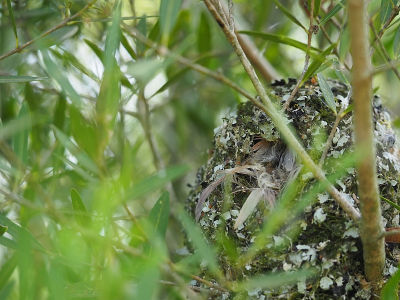
Nest in the Phillyrea angustifolia
The late winter and spring this year have been surprisingly wet - interspersed with warm sunny spells. As a result, the garden has surged into growth and some plants that didn’t budge for years have unexpectedly almost doubled in size in the space of a couple of months. As for the grass … it has grown ‘as high as an elephant’s eye’.
Medical worries have rather kept me out of the garden so far this year, so it was with great relief that a new team of gardeners has come to my rescue. They started work here in mid May, by which time the pathways around the garden had become impassable. They have trimmed back a lot of shrubs and got the grass under control. This morning, for the first time in months, I was able to take a walk around the garden unimpeded. It was really lovely. And no, I am not going to show you any ‘before and after’ photos as it is too embarrassing
The new gardeners are a breath of fresh air, not least because they are actually interested in plants and wildlife; they already know the names of most of the plants and how to care for them. They take an interest in new varieties of plants and seem to delight in the fact that this garden is so natural and varied, despite the unkempt chaos.
In the course of these efforts to restore the garden to me they discovered several birds’ nests in the shrubs. Each nest has been careful replaced as it was found and we have had a guess at who might be the owner. Particularly helpful is the recent publication by Susan Ogilvy ‘Nests’ whose delicious paintings of nests at life size is a real wonder. She was recording nests in England but most of the bird species are found here in Umbria too.
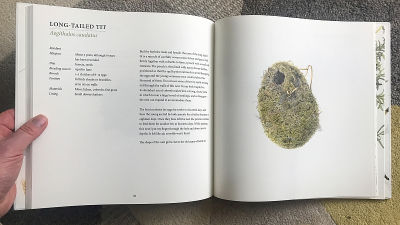
Long-tailed tit nest by Susan Ogilvy
What is particularly interesting in the book is that each type of nest is identified not only by which bird it belongs to, how and where it is constructed, but also how many years the bird will return and re-use it. I was amazed to read that the long-tailed tit (Aegithalos caudatus) re-uses its nest for five years. The nest we found in the Phillyrea angustifolia looks like it might be one of theirs, so it is just as well that was put back carefully, and we hope the owners won’t notice and will come back to stay there again next year.
So the garden has been restored to me but the paradise is made complete by the haven it created for birds with such lush shrubbery. Paradise regained for all of us.
Design - All of a Twitter - March 2021
The quiet of lockdown allows us to hear bird song so much louder than before. Going about their birdy business, the gathering of nesting materials, the pairing up, the feeding and scurrying about are accompanied by a frantic tweeting. The finches and warblers seem in competition to out-sing each other. I like to think they sound happy - thanks to the sanctuary of my garden - but more likely they are hurling abuse and making threats. In fact just like the online Twitter.
And we can’t wait for the return of the swallows in April: Simon and Garfunkel sing about their seasonal migration here.
A ‘new’ discovery for me is the Black Redstart who has been pecking around the terrace, with a distinctive orangey/red flash on his wings. Here is the RSPB description and song.
The other red-feathered bird, charming when keeping me company whilst I dig in the garden, the Robin is quite a thug. His territorial aggression knows no bounds: last autumn I found him fighting another robin who had dared to venture into ‘his’ patch - to the death. The next day, all that remained was a pair of wings…
In the garden we can create bird friendly environments simply by selecting the right trees and shrubs that will provide shelter and living space. I have tried putting down bird food, but my avian neighbours just turn up their beaks at it, so my efforts are directed at providing plants which will either produce seeds, nectar or attract insects, for which native plants are usually the best. Of course, I also avoid using weed killer or insecticide. Melissa Hamilton (of this parish) has more expert advice here.
The time for pruning and trimming is still with us - but be careful not to disturb nesting birds. There is somebody (a finch?) who usually makes a very small, neat nest in a shrub close to the ground - but never in the same place so I don’t know where to look for it.
Getting a buzz - May 2020
With the noise of traffic and machinery muted in the recent weeks, the sounds of nature have been ‘dialled up’ to the max. Not only has birdsong been really loud but also the buzzing of insects. The flowering shrubs in my garden are positively alive with insects and their sounds can be heard from a distance.
Take a moment to go out into your garden - yes you can take that glass of wine - and listen. Which plants are making the loudest sound? Where’s the buzz?
To get us in the mood here is the Bee Song.
I bet you will find that tubular flowers or little trumpet shapes will be the most popular. Plants which are native to the area or their close hybrids will also score highly, as will simple flowers rather than complicated hybridised forms. Here are three butterflies I saw in my garden this morning, all of them feeding on native plants:
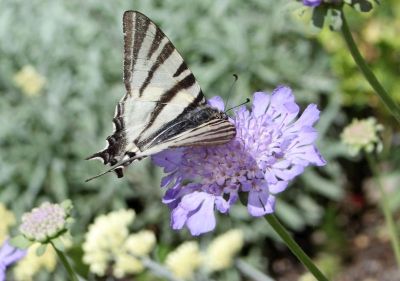
Scarce Swallowtail on Scabious
Some insects are more welcome than others (death to all Lily Beetle!), but we should be vigilant about providing nectar for bees: if we lose our bees then most agriculture will fail and we will be in a right pickle.
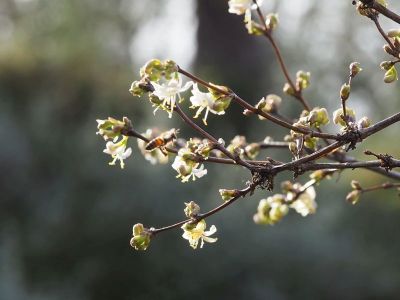
Honey bee visiting Winter Honeysuckle in February
Try to plant flowers that will bloom right through the year: starting with bulbs like crocus and grape hyacinth, these will be welcome for bees walking up from winter dormancy.
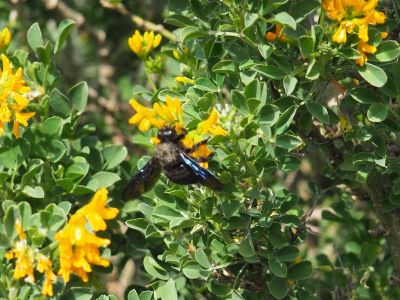
Carpenter bee visiting Medicago in March
Of course the garden is brimming with flowers at the moment but don’t forget high summer: perovskia, tulbaghia and bupleurum will keep going during the hottest days. In autumn the bees will be looking to stock up for winter - caryopteris, rosemary and abelia will be appreciated by them.
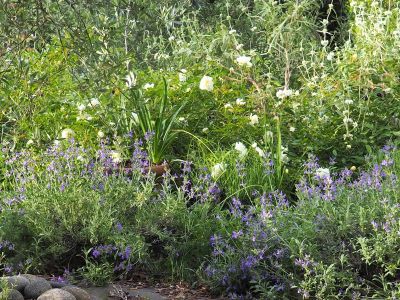
Salvia lavandulifolia subsp. blancoana with rose ‘Alberic Barbier’ and Phlomis purpurea 'Alba'
The flower bed under my window at the moment is a bee heaven.
Having got rather accustomed to all the buzzing it took me a while to realise that the really loud buzz was coming from the window above. There I discovered a swarm of bees had settled on the inside of the shutters … Yikes! What to do?
I resisted the advice from neighbours to kill them off and instead made a call to our Castiglione del Lago Newsletter editor, who immediately put me in touch with local beekeeper Doreen Sutton. I am delighted say that with great skill she saved the swarm and took the bees to a new home. It was magical to watch.
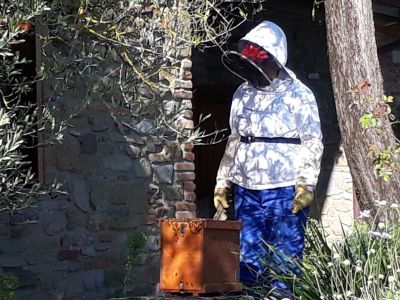
Swarm transferring to a special box
The Queen Bee was first persuaded to go into a special box and immediately all the rest of the swarm followed her. Doreen told me that it was hardly surprising that there were bees trying to set up home in my garden as there were so many bee-friendly flowers. I was really proud.
The photo at the top of this page shows a Common Wall Lizard (Podarcis muralis)
All text and photographs © Yvonne Barton unless stated otherwise